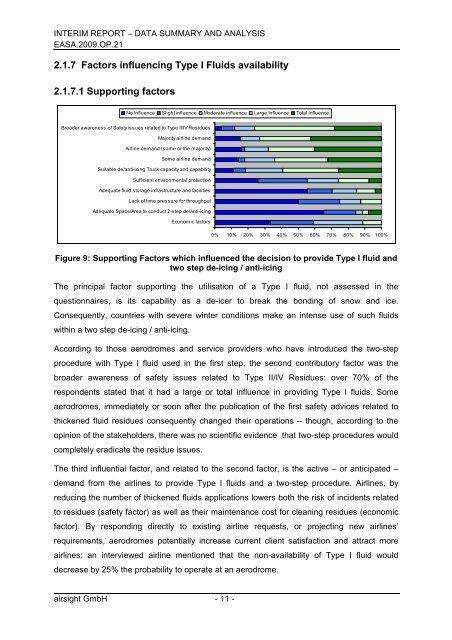Interim Report - Introduction - EASA
Interim Report - Introduction - EASA
Interim Report - Introduction - EASA
You also want an ePaper? Increase the reach of your titles
YUMPU automatically turns print PDFs into web optimized ePapers that Google loves.
INTERIM REPORT – DATA SUMMARY AND ANALYSIS<br />
<strong>EASA</strong>.2009.OP.21<br />
2.1.7 Factors influencing Type I Fluids availability<br />
2.1.7.1 Supporting factors<br />
No Influence Slight influence Moderate influence Large Influence Total influence<br />
Broader awareness of Safety issues related to Type II/IV Residues<br />
Majority airline demand<br />
Airline demand (some or the majority)<br />
Some airline demand<br />
Suitable de/anti-icing Truck capacity and capability<br />
Sufficient environmental protection<br />
Adequate fluid storage infrastructure and facilities<br />
Lack of time pressure for throughput<br />
Adequate Space/Area to conduct 2-step de/anti-icing<br />
Economic factors<br />
airsight GmbH - 11 -<br />
0% 10% 20% 30% 40% 50% 60% 70% 80% 90% 100%<br />
Figure 9: Supporting Factors which influenced the decision to provide Type I fluid and<br />
two step de-icing / anti-icing<br />
The principal factor supporting the utilisation of a Type I fluid, not assessed in the<br />
questionnaires, is its capability as a de-icer to break the bonding of snow and ice.<br />
Consequently, countries with severe winter conditions make an intense use of such fluids<br />
within a two step de-icing / anti-icing.<br />
According to those aerodromes and service providers who have introduced the two-step<br />
procedure with Type I fluid used in the first step, the second contributory factor was the<br />
broader awareness of safety issues related to Type II/IV Residues: over 70% of the<br />
respondents stated that it had a large or total influence in providing Type I fluids. Some<br />
aerodromes, immediately or soon after the publication of the first safety advices related to<br />
thickened fluid residues consequently changed their operations – though, according to the<br />
opinion of the stakeholders, there was no scientific evidence that two-step procedures would<br />
completely eradicate the residue issues.<br />
The third influential factor, and related to the second factor, is the active – or anticipated –<br />
demand from the airlines to provide Type I fluids and a two-step procedure. Airlines, by<br />
reducing the number of thickened fluids applications lowers both the risk of incidents related<br />
to residues (safety factor) as well as their maintenance cost for cleaning residues (economic<br />
factor). By responding directly to existing airline requests, or projecting new airlines’<br />
requirements, aerodromes potentially increase current client satisfaction and attract more<br />
airlines: an interviewed airline mentioned that the non-availability of Type I fluid would<br />
decrease by 25% the probability to operate at an aerodrome.

















